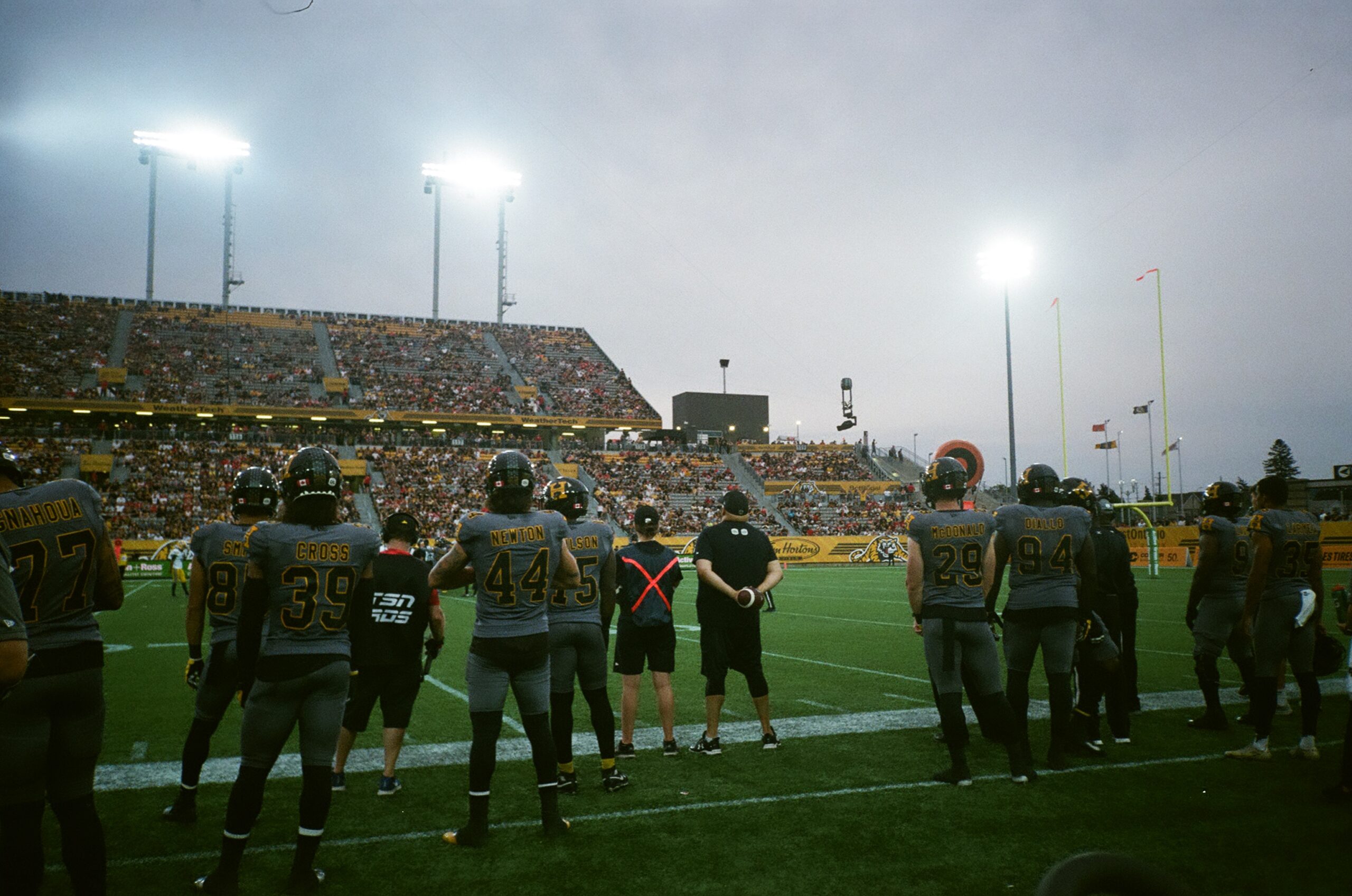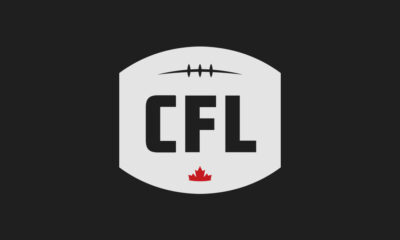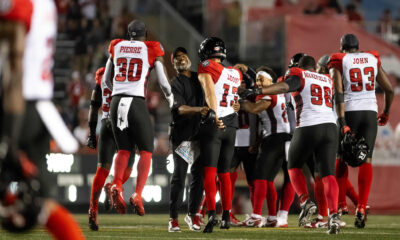
For most people, North American professional gridiron football means the game played in the United States, as seen in the National Football League (NFL). But a version is played in Canada as well – the CFL. Outwardly, the two leagues appear to be playing the same sport, but the Canadian game is distinct: Canadian football fields are both longer and wider, the game has three downs rather than four, and each team plays 12 players instead of 11.
And there is one more thing that makes the Canadian game unique: the Game Rule Ratio.
The Game Ratio Rule – which in reality means a quota on Americans – is venerable. It has been around in one form or another since 1936, coming into place after the now-defunct Winnipeg ‘Pegs won the Grey Cup with eight Americans (imports) on their roster.
The League’s official position is that the ratio is necessary to keep the game uniquely Canadian.
“Football is ingrained into American people. It’s kind of like hockey for Canadians,” said Dave Dickenson, Calgary Stampeders coach and former American CFL player. “Canadian players need a bit of an advantage to get in there and be immersed in the game. That’s where the ratio comes in.”
However, the ratio rule has an extensive history of being a polarizing topic of debate within the league. It has changed several times throughout the years, most recently for the 2023 season during the league’s collective bargaining.
Breaking down the ratio
A simple idea has over the years become increasingly more complicated. It causes some of the league’s best players to be deemed “backups” so a team can have more roster flexibility.
The 2023 version of the ratio rule requires teams to have a minimum of 21 Canadian players, seven of them being starters. Teams can only have a maximum of 19 Americans, not including quarterbacks.
Confusingly, there are in the current rule now six roster designations: “nationals”, “Americans”, “Globals”, “designated Americans”, “designated nationalized Americans”, and “designated nationals”. Each has its own rules.
For example, a designated American is defined as a non-starting American player who can only replace an American player on the field. Nationalized American players, on the other hand, are defined as having played with their current team for three years or at least five years in the league. They can also replace a designated National player for up to 23 snaps, as long as they aren’t in the starting lineup.
“It’s not a positive for our league to have your best players not listed as your starter,” Dickenson said. “Once you break your team into categories, you are breaking your team chemistry, and confusing the fans.”
For example, the Calgary Stampeders’ Ka’Deem Carey is arguably one of the CFL’s best running backs, recording 19 rushing touchdowns since entering the CFL in 2019. Yet Carey and some of his fellow Americans have to spend much of the game warming the bench, despite typically recording higher stats compared to some of their Canadian counterparts.
The business of Canadian football
“The CFL is not a profitable league,” David Asper, former chairman of the Winnipeg Blue Bombers said. “If you look at it from a business perspective, the number of high-caliber and profitable football players in the U.S. far exceeds the number of high-caliber football players in Canada.”
As a result of the law of supply and demand, it is more economical to hire American players versus Canadians.
“If you’re a general manager, and there are only a handful of Canadian receivers who can compete with a large number of American receivers, it makes them (Canadians) more valuable,” former Canadian player Jock Climie said. “There is an upward pressure on Canadian salaries, as a result of the ratio.”
In the NCAA, there are 133 Division 1 football programs, producing thousands of players eligible for professional careers every year. In stark contrast, there are only 27 U SPORTS football programs in Canada, meaning there is a smaller talent pool to choose from to satisfy the ratio.
Gregory Peterson, a Canadian who played for nine seasons with the Calgary Stampeders, went to Brigham Young University in Utah for his college football career because American football culture is more established in terms of both resources and fan support.
“With Canadian college football, they get 10,000 fans out at the most,” Peterson said. “I loved playing and training in the U.S. I loved the atmosphere at the games. We just don’t have it at the same level in Canada.”
Furthermore, Canadian youth-level sports do not have the same system of recruitment and funding as their American counterparts.
“In the U.S. they’re paying high school coaches six-figure salaries,” Dickenson said. “ In Canada, coaches do it for free.”
Canadian high school and minor league sports often rely on donations to operate at a recreational level, rather than as a business.
“We simply just don’t have big-time high school football,” long-time Canadian sports journalist Steve Milton said. “You don’t see any high school stadiums of 15 to 25,000 like we do in the United States.”
As a result of Canadian football being underfunded, there are constraints put on who can participate in the sport at a high-performance level.
“There is more opportunity in the United States for people from diverse backgrounds to have an opportunity to play football,” said Ron Foxcroft, NCAA referee and consultant to the Canadian Professional Football Officials Association. “If you’re going to play in Canada, you better expect to pay for it on your own. We just don’t have the same level of budgets for scholarships.”
In other words, the Canadian model of player development works against equal opportunities for inclusion.
Dwindling fan support
Unlike many other professional sports leagues, the CFL business model relies significantly on fan support and ticket sales to sustain revenue.
As a result of the COVID-19 pandemic, which involved the cancellation of the 2020 season and significantly reduced attendance in 2021, the league lost an estimated $80 million. Teams have expressed concern about both sustaining and diversifying their fanbases as well.
To put this into perspective, according to the Angus Reid Institute, 62 percent of football fans in Canada would opt to watch the NFL’s Super Bowl over the CFL’s Grey Cup. Furthermore, in the country’s largest city, the 2022 Grey Cup champion Toronto Argonauts struggle to sell more than 20,000 tickets a game. The Toronto FC soccer team, which shares a stadium with the Argonauts, typically outsells the Argonauts by 25%.
“Back in the 80s, the CFL did a very poor job marketing to young people. They lost an entire generation of fans,” Foxcroft said. “With the NFL, they focused on the younger crowd.”
For the CFL to go on, some argue that changes must be made, starting with a focus on what the fans want. The question is, could a changed ratio rule that focuses on supporting Canadian talent be part of the fix?
Promoting Canadian talent
Many Canadian players seem to think so. Stu Laird, a former Canadian player and the former president of the CFL Players Association, says he would not have gotten the opportunity to play in the league without the ratio.
“The ratio helps quite a bit in the development of the Canadian player. It highlights local talent,” Laird said. “There are a lot of fans that like to see the Canadian players in the league competing. At the end of the day, it becomes the fan’s game.”
David Estok, a lifelong CFL fan and former editor of The Hamilton Spectator, the hometown paper of the CFL’s Hamilton Tiger-Cats, shares this sentiment.
“With CFL players, you know they aren’t doing it for the money or the fame,” Estok said. “They’re doing it because they love football.”
Considering the fact that Canadian football players are motivated strongly by passion, many argue that the ratio can be a tool to help players grow as athletes.
“To grow the CFL, we have to grow grassroots football,” Peterson said. “ Without the ratio, I don’t think we’d have many kids aspiring to play. If we’re going to get Canadians playing in the CFL, the best way to do it is to give them time to develop.”
This is something that the CFL has already begun to take note of. In 2022, the CFLPA launched the “First Down” initiative to help introduce kids to the sport.
“Randy Ambrosie (the CFL Commissioner) is starting to change the league’s business too,” Foxcroft said. “He understands things because he was a player. He’s beginning to market to younger audiences.”
Alanna Nolan, a lifelong CFL fan and former sideline reporter for the Calgary Stampeders, notes that the league could benefit from marketing to female fans as well.
“When it comes to attracting female fans, I think it’s just an understanding of the game that can sometimes act as a barrier,” Nolan said. “I think if we do a better job of making this game accessible we can really open up this space.”
Where does the CFL go from here?
The CFL has proposed an expansion into Atlantic Canada, specifically motivated by the fact that the league has a large fanbase in Halifax. However, a tenth team would mean at least 21 new Canadian players to satisfy the ratio.
Many people involved in this debate agree on one thing: for the ratio to serve a purpose, it must be revised to be less complicated.
“Back in the 1960s, the ratio just needed 21 Canadians. And if you played in the league for five years, you were deemed to be a Canadian,” Foxcroft said. “We all understood it, it was real simple. I’m the most ardent CFL fan on the planet, but I don’t like the fact that under the current rule, you have so many restrictions.”
The intricacies of the 2023 version of the rule cause issues for the league on several fronts.
“It is a confusing deal,” Dickenson said. “It causes confusion for the players, and you try to explain it to them but they don’t understand why they can’t run out of the tunnel as a starter.”
Ultimately, without happy players, there are no happy fans.
CFL fans are ride or die

CFL fans during a Hamilton Tiger-Cats game. (Mohana Holloway photo).
“I think they’ve overcomplicated the rule,” Foxcroft said. “If you have to keep the ratio in the command center on a computer, it is simply too complicated for the fans.”
A majority of CFL fans recognize that the game rule ratio does serve a purpose. However, many argue that the intricacies of the current version take away from the game of Canadian football.
They simply want the CFL to highlight Canadian talent.
“You hear the argument, why not just play the best players, who cares where they come from,” Estok said. “The truth is, it’s an integral part of the Canadian game that only the very best teams that win consistently have to have really good Canadians. I think it really uplifts Canadian players.”
Considering the fact that Canadian football is played in a unique way, some American players perform better in the CFL as well.
“The Canadian game is very well suited to certain kinds of American players,” Asper said. “This league has a deep affinity and history for our American players who’ve come to play for our teams and live in our communities. I think it might be one of the things that brings our league forward.“
Many former American players have decided to make Canada their post-career home, because of the welcoming nature of the CFL.
“If you didn’t have the ratio, we wouldn’t have Canadians and Americans deciding to stay up here,” Peterson said. “Most of the guys I played with have become pillars in our community.”
The simplistic nature of the CFL allows fans to develop a strong affinity for their team on an intimate level. Fans are able to grow a love for players, regardless of their nationality.
“Our players are extremely accessible,” Estok said. “Fans can get to know players, and even become friends with them, because they’re not making millions of dollars. They just love football.”
Over the years, the ratio has gone back and forth with changes. For the 2024 season, it is still unclear whether or not the rule will be revised. However, one thing has remained the same since the inception of the league: the love the fans have for the Canadian game.
“I will always be a fan,” Nolan said. “I just think it’s so much more exciting. I love that anything can happen in the final three minutes. When it comes to Canadian football, it’s uniquely Canadian. And that makes for a great brand of football.”
Continue the CFL Football discussions on our offical CFL Discord Channel

1 Comment
Leave a Reply
Cancel reply
Leave a Reply
Big Announcement: CFL Unveils Free Live Streaming Platforms
Get Alerts & Stay Connected
CFL iPhone AppCFL Android App


















Michael Muldoon
December 22, 2023 at 12:58 pm
Great article. I note Ron Foxcroft’s comment: “Back in the 80s, the CFL did a very poor job marketing to young people. They lost an entire generation of fans. With the NFL, they focused on the younger crowd.”
This really nails something. The CFL’s marketing is very badly hurt by its stupid contract with TSN. TSN is not part of the standard cable package in Canada, so its availability is limited in large swaths of the country. I have friends who only see the CFL when they go to games with me because I have an extra ticket. TSN, which is owned by BellMedia, also heavily promotes NFL broadcasts available on CTV, also owned by BellMedia. CTV is included in standard cable packages, which means TSN is promoting NFL games that can be watched on free TV during its CFL broadcasts that can only be seen on a network you have to pay extra for. How are the Argonauts supposed to compete with that when they are not even on a huge percentage of televisions right in Toronto?
Add to that the fact that TSN’s broadcasts have been stagnant for well over a decade, with little to no innovation or change. Almost the only thing that distinguishes a TSN 2012 CFL broadcast from a 2023 one is the player uniform designs. One example of not keeping up: CBS, NBC, ABC, ESPN, and Fox have put little timeout markers on the on-screen scoreboard for nearly 20 years. TSN just added it them to CFL broadcasts in 2023! That’s absolutely ridiculous!
TSN knows they have a monopoly on the CFL, so they do almost nothing to improve their presentation. You need to do things that attract younger viewers, but TSN goes bare-bones. They’ve used the same studio setup for years, the bland, boring, red-heavy one they also use for hockey, baseball, basketball, and soccer. The panel is terrible. Kate Bierness is absolutely awful, and Davis Sanchez is insightful but has the charisma of a couch cushion. Modernize!!! Please!!!
The CFL would be doing itself a huge favour if it could actually split coverage between two networks, much like the NFL does with the AFC mostly on CBS and the NFC mostly on Fox. Once a fan finishes watching their team play, there is competition between CBS and Fox on Sundays to attract them to other games. This forces them to be creative. If West Division games were on TSN and East Division games were on Global or Rogers, TSN might actually have to change something in their bland broadcasts. The networks would drive one another. Then they might attract more viewers to watch the talent that Canadian players bring to the field when given the opportunity.